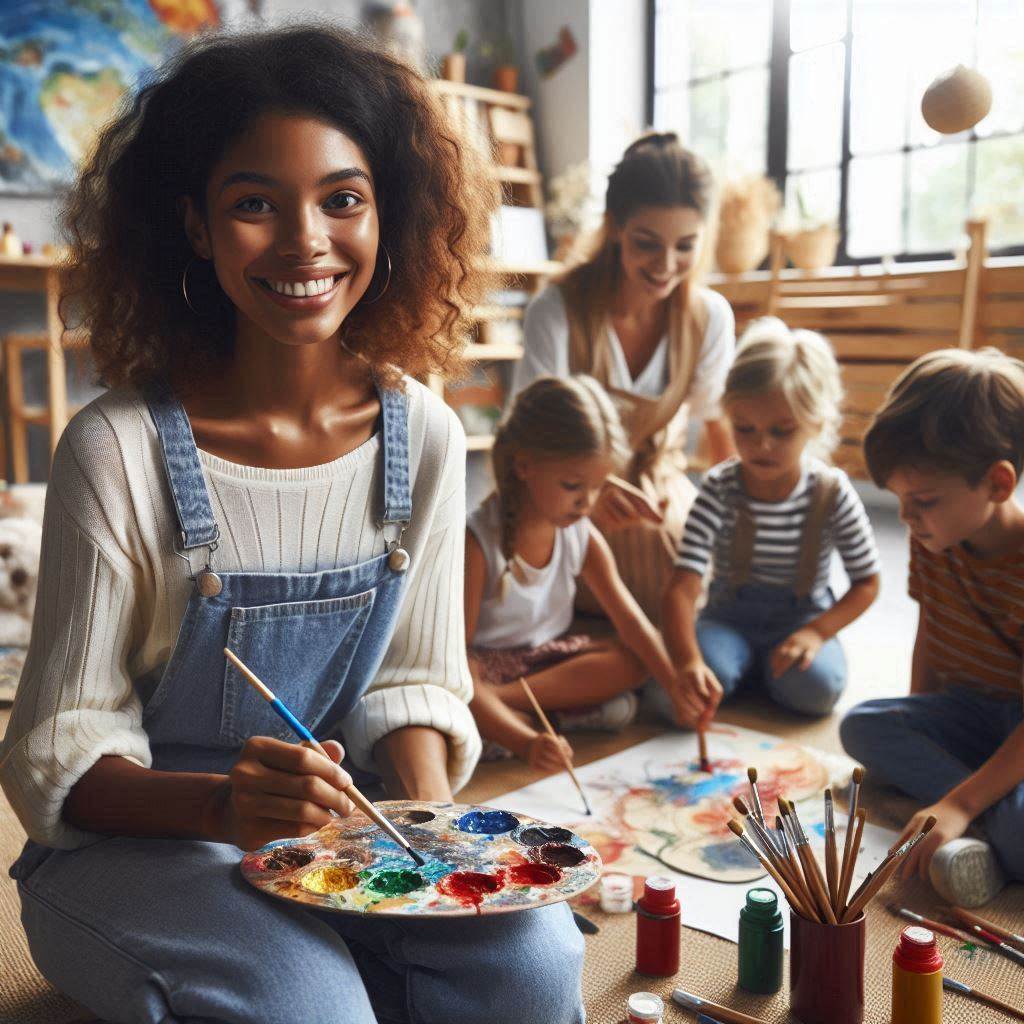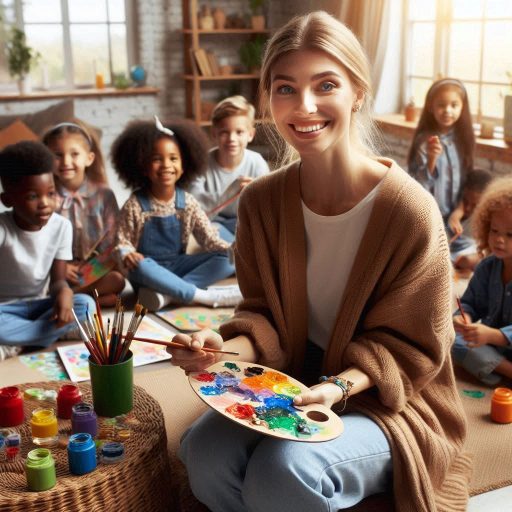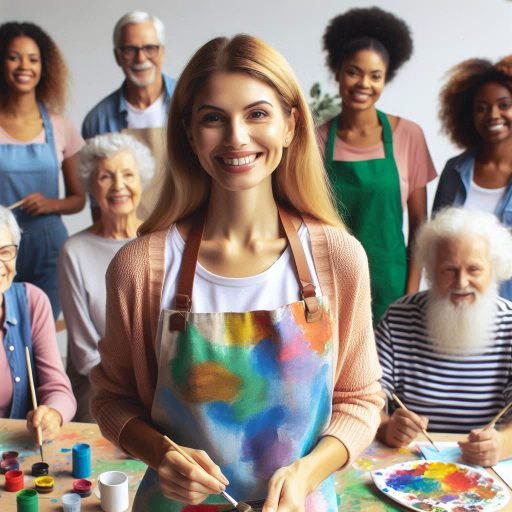Introduction
Art therapy is a therapeutic approach that utilizes creative expression to enhance mental health and emotional well-being as Mental Health and Healing Art Therapy.
It combines traditional therapeutic techniques with the creative process of making art, allowing individuals to express themselves in non-verbal ways.
Through various mediums‘such as painting, drawing, sculpture, and collage‘participants can explore their feelings, thoughts, and experiences, facilitating deeper self-understanding.
Art therapy is conducted by trained professionals who guide individuals in using art as a means of communication and healing.
Mental health is a crucial aspect of overall well-being, influencing how we think, feel, and act in daily life.
It plays a significant role in our ability to cope with stress, relate to others, and make decisions.
Prioritizing mental health is essential for leading a fulfilling life, and healing from emotional distress is vital for personal growth and resilience.
In a world that often overlooks the importance of mental health, art therapy serves as a valuable resource, offering support and healing through creativity.
The benefits of art therapy are numerous and profound.
It can help individuals process trauma, reduce anxiety, and improve self-esteem.
Engaging in artistic activities promotes mindfulness, allowing people to be present in the moment and experience a sense of calm.
Art therapy also encourages emotional exploration, enabling individuals to confront and work through difficult feelings in a safe and supportive environment.
This holistic approach not only fosters creativity but also empowers individuals to take charge of their healing journey.
As we delve deeper into the benefits of art therapy, it becomes clear that it is an essential tool for enhancing mental health and facilitating healing.
Reducing stress and anxiety
Using Art as a Form of Expression
Art therapy offers a creative outlet for emotional expression, helping individuals release pent-up feelings through non-verbal means.
Engaging in activities like painting or drawing allows people to communicate emotions they may struggle to express with words.
This form of expression helps externalize inner experiences, reducing emotional tension.
Art therapy empowers individuals to explore their thoughts and feelings without fear of judgment, making it a safe and therapeutic space for self-reflection and healing.
Promoting Relaxation and Mindfulness
Creating art promotes relaxation by shifting focus away from daily stressors.
When individuals engage in artistic activities, they enter a meditative state, which encourages present-moment awareness.
This mindfulness helps break the cycle of anxious thoughts by focusing attention on the act of creation.
As people immerse themselves in the art-making process, they become more centered and calm.
The repetitive nature of many art techniques, like sketching or sculpting, further enhances relaxation and leads to mental clarity.
Lowering Cortisol Levels in the Body
Art therapy is proven to lower cortisol, the body’s primary stress hormone.
Cortisol regulates the body‘s response to stress, but excessive levels can lead to anxiety and health problems.
Through creative activities, art therapy helps reduce cortisol levels, bringing the body back into balance.
This decrease in cortisol not only improves mental well-being but also promotes physical health by reducing the harmful effects of prolonged stress.
Lower cortisol levels lead to improved mood and overall emotional stability.
Art therapy significantly reduces stress and anxiety.
By offering a way to express emotions, promoting relaxation through mindfulness, and lowering cortisol, art therapy enhances mental health and fosters emotional resilience.
Regular practice of art therapy techniques can help individuals develop healthy coping strategies and maintain a sense of inner peace.
Read: How to Create Memorable Characters: Pro Tips
Encouraging Self-Exploration and Self-Awareness
Art therapy fosters self-exploration and self-awareness, providing individuals with a unique avenue to understand their thoughts and emotions.
Through creative expression, people can delve into their inner world and confront feelings they may have previously overlooked.
This process allows individuals to visualize their thoughts and feelings, enabling them to engage with their emotions in a constructive way.
Allowing Individuals to Explore Their Thoughts and Emotions
Art therapy invites individuals to explore their thoughts and emotions in a safe environment.
The act of creating art can evoke feelings and memories that require attention.
Whether through painting, drawing, or sculpting, individuals have the freedom to express themselves without judgment.
This exploration can lead to breakthroughs in understanding, allowing individuals to process complex emotions and gain clarity.
Helping Individuals Gain Insight into Their Own Experiences
Through self-expression in art, individuals often gain valuable insights into their experiences.
The creative process encourages reflection, helping them connect the dots between their emotions and behaviors.
As individuals analyze their artwork, they can identify patterns and themes that reveal underlying issues.
This newfound awareness can empower them to make positive changes in their lives.
Enhancing Self-Esteem and Self-Acceptance
Participating in art therapy can significantly enhance self-esteem and self-acceptance.
As individuals create art, they experience a sense of accomplishment and pride in their work.
This boost in confidence can improve their overall self-image.
Furthermore, art therapy encourages individuals to embrace their uniqueness and appreciate their creative expressions.
This acceptance fosters a positive self-concept and helps individuals cultivate compassion toward themselves.
In summary, art therapy plays a vital role in encouraging self-exploration and self-awareness.
By allowing individuals to delve into their thoughts and emotions, helping them gain insight into their experiences, and enhancing self-esteem and self-acceptance, art therapy promotes personal growth and healing.
Regular engagement in this creative process can lead to lasting emotional benefits and a deeper understanding of oneself.
Read: Ceramic Art Exhibitions to Visit in 2024
Providing a Healthy Coping Mechanism
Art therapy serves as a valuable tool for providing healthy coping mechanisms.
It enables individuals to express emotions creatively, helping them process feelings in a constructive manner.
By utilizing various artistic forms, people can channel their emotions, transforming pain and stress into something tangible.
This creative outlet empowers individuals to confront difficult feelings instead of suppressing them, promoting emotional healing.
Offering a Creative Outlet for Emotions
Art therapy offers a safe space for individuals to explore and express their emotions.
Engaging in creative activities like drawing or painting allows people to depict their inner experiences visually.
This process helps them articulate feelings they may struggle to communicate verbally.
By externalizing emotions through art, individuals can better understand and cope with their feelings, reducing emotional distress.
Teaching Individuals Healthy Ways to Manage Stress
Through art therapy, individuals learn healthy strategies for managing stress.
The act of creating art can be calming, providing an opportunity to relax and unwind.
This therapeutic process teaches participants to focus on the present moment, diverting attention from stressors.
As individuals create, they can develop healthier coping skills, such as mindfulness and self-soothing techniques, which can be applied in everyday situations.
Offering a Distraction from Negative Thoughts
Art therapy effectively offers a distraction from negative thoughts and overwhelming feelings.
When individuals immerse themselves in the creative process, they redirect their focus away from anxiety or sadness.
This distraction can provide relief, helping to break the cycle of negative thinking.
Engaging in art allows individuals to explore new perspectives and fosters a sense of accomplishment, further alleviating stress and anxiety.
Art therapy provides a healthy coping mechanism that promotes emotional well-being.
By offering a creative outlet for emotions, teaching individuals healthy ways to manage stress, and providing a distraction from negative thoughts, art therapy supports personal growth and healing.
Regular participation in art therapy can enhance emotional resilience and empower individuals to navigate life’s challenges more effectively.
Read: Character Design Trends: What‘s Hot in 2024?

Improving Communication and Interpersonal Skills
Art therapy plays a significant role in improving communication and interpersonal skills.
By utilizing creative expression, individuals can communicate their thoughts and feelings in non-verbal ways.
This approach allows participants to explore emotions they might struggle to articulate verbally.
As they engage in artistic activities, individuals can convey complex feelings, fostering a deeper understanding of themselves and their relationships with others.
Facilitating Communication Through Non-Verbal Means
One of the key benefits of art therapy is its ability to facilitate communication through non-verbal means.
Many individuals find it easier to express themselves visually rather than verbally.
Creating art allows participants to share their experiences without the pressure of finding the right words.
This form of communication can be especially beneficial for those who have difficulty discussing their emotions openly, creating a safe and supportive environment for expression.
Enhancing Problem-Solving Skills
Art therapy also enhances problem-solving skills by encouraging creative thinking.
As individuals engage in the art-making process, they learn to approach challenges from different angles.
This flexibility in thinking fosters innovative solutions to problems, both within the creative context and in their daily lives.
The ability to experiment and take risks in art can translate into greater confidence when facing real-life challenges, improving overall problem-solving capabilities.
Building Trust and Rapport with the Therapist
Participating in art therapy helps build trust and rapport between individuals and their therapists.
The non-threatening environment created by art activities encourages open communication and vulnerability.
As individuals share their artwork and creative process, they develop a sense of safety, allowing for deeper emotional exploration.
This trust is crucial for effective therapy, as it enables individuals to engage more fully in the therapeutic process.
Art therapy significantly improves communication and interpersonal skills.
By facilitating communication through non-verbal means, enhancing problem-solving skills, and building trust and rapport with therapists, art therapy fosters personal growth and emotional healing.
Regular engagement in art therapy can lead to more effective communication in relationships and improved overall interpersonal dynamics.
Read: How to Price Your Ceramic Artwork
Transform Your Career Today
Unlock a personalized career strategy that drives real results. Get tailored advice and a roadmap designed just for you.
Start NowBoosting Cognitive Function
Art therapy is an effective way to boost cognitive function, enhancing various mental skills.
Engaging in creative activities stimulates different areas of the brain, promoting overall cognitive health.
As individuals participate in art therapy, they can improve memory, executive function, and creative thinking.
This multifaceted approach supports mental agility and promotes better problem-solving abilities.
Enhancing Memory and Executive Function
Art therapy enhances memory and executive function by requiring individuals to focus on various tasks simultaneously.
When creating art, participants must remember techniques, colors, and forms, which actively engages their memory.
This mental engagement exercises cognitive abilities, improving information retention and recall.
Additionally, art activities require planning and organization, skills closely linked to executive function.
By practicing these skills in a creative context, individuals can enhance their cognitive performance in everyday life.
Stimulating Creative Thinking and Problem-Solving
Participating in art therapy stimulates creative thinking and problem-solving skills.
The open-ended nature of artistic expression encourages individuals to think outside the box.
As they experiment with different materials and techniques, they learn to approach challenges from diverse perspectives.
This creative exploration fosters resilience and adaptability, essential traits for effective problem-solving.
The ability to view issues through an artistic lens can lead to innovative solutions in various aspects of life.
Fostering a Sense of Accomplishment and Pride
Art therapy fosters a sense of accomplishment and pride, which significantly contributes to cognitive function.
Completing an art project provides individuals with tangible results, boosting self-esteem and confidence.
This feeling of achievement encourages further engagement in creative activities, promoting ongoing cognitive development.
As individuals see their artistic growth, they become more motivated to explore new ideas and techniques, enhancing their overall cognitive skills.
Art therapy effectively boosts cognitive function through various mechanisms.
By enhancing memory and executive function, stimulating creative thinking and problem-solving, and fostering a sense of accomplishment and pride, art therapy supports mental health and cognitive development.
Regular participation in art therapy can lead to improved cognitive abilities, contributing to overall well-being and personal growth.
Gain More Insights: Designing with Grids: A Typography Perspective
Find Out More: Trends in Custom-Made Jewelry
Enhancing Emotional Resilience
Art therapy plays a crucial role in enhancing emotional resilience, equipping individuals with the tools to navigate life’s challenges.
By engaging in creative expression, participants learn to adapt to change and develop coping strategies for overcoming adversity.
This therapeutic approach fosters a greater understanding of emotions, promoting mental strength and resilience in the face of difficulties.
Teaching Individuals to Adapt to Change and Overcome Challenges
Art therapy teaches individuals to adapt to change by encouraging flexibility and exploration.
Through the creative process, participants confront their feelings about change and develop strategies for managing uncertainty.
Engaging in artistic activities allows individuals to visualize their challenges, making them more manageable.
This adaptability nurtures resilience, empowering individuals to approach future obstacles with confidence and a positive mindset.
Building Emotional Intelligence and Regulation Skills
Art therapy also builds emotional intelligence and regulation skills, crucial components of emotional resilience.
Participants learn to identify and articulate their emotions through artistic expression, increasing their emotional awareness.
This heightened understanding allows individuals to recognize their feelings without becoming overwhelmed.
Art therapy provides tools for emotional regulation, enabling participants to respond to stressors calmly and thoughtfully, ultimately strengthening their resilience.
Strengthening the Ability to Bounce Back from Setbacks
Engaging in art therapy can strengthen an individual’s ability to bounce back from setbacks.
The process of creating art often involves trial and error, reflecting real-life challenges.
By learning to embrace imperfections and view mistakes as opportunities for growth, participants develop a healthier perspective on setbacks.
This mindset fosters resilience, enabling individuals to recover more quickly from disappointments and face future challenges with renewed determination.
Art therapy significantly enhances emotional resilience by teaching individuals to adapt to change, building emotional intelligence, and strengthening their ability to bounce back from setbacks.
By engaging in creative expression, participants cultivate essential skills that support mental health and personal growth.
Regular participation in art therapy can lead to increased resilience, empowering individuals to navigate life‘s challenges with confidence and grace.
Conclusion
Art therapy offers numerous benefits for mental health and healing.
It provides a creative outlet for expression and promotes self-awareness.
Engaging in art therapy can reduce stress, anxiety, and depression while improving overall well-being.
It allows individuals to process emotions and experiences.
Art therapy fosters a sense of empowerment and control, helping individuals regain a sense of purpose and identity.
It encourages self-discovery and personal growth.
By tapping into the therapeutic power of art, individuals can explore their inner thoughts and feelings in a safe and supportive environment.
It can enhance communication skills and emotional resilience.
Art therapy is a valuable tool for self-care and self-expression.
It can be particularly beneficial for those who find it challenging to verbalize their emotions.
We urge individuals to consider art therapy as a positive outlet for their mental health and well-being.
It is a non-invasive and creative way to address underlying issues.
Remember, prioritizing mental health is essential, and seeking help when needed is a sign of strength.
Art therapy offers a unique approach to healing and self-discovery.
[E-Books for Sale]
The Big Book of 500 High-Paying Jobs in America: Unlock Your Earning Potential
$19.99 • 500 High-Paying Jobs • 330 pages
Explore 500 high-paying jobs in America and learn how to boost your career, earn more, and achieve success!
See All 500 High-Paying Jobs of this E-Book
1001 Professions Without a Degree: High-Paying American Jobs You Can Start Now
$19.99 • 1001 Professions Without a Degree • 174 pages
Discover 1001 high-paying jobs without a degree! Unlock career tips, skills, and success strategies for just $19.99!




